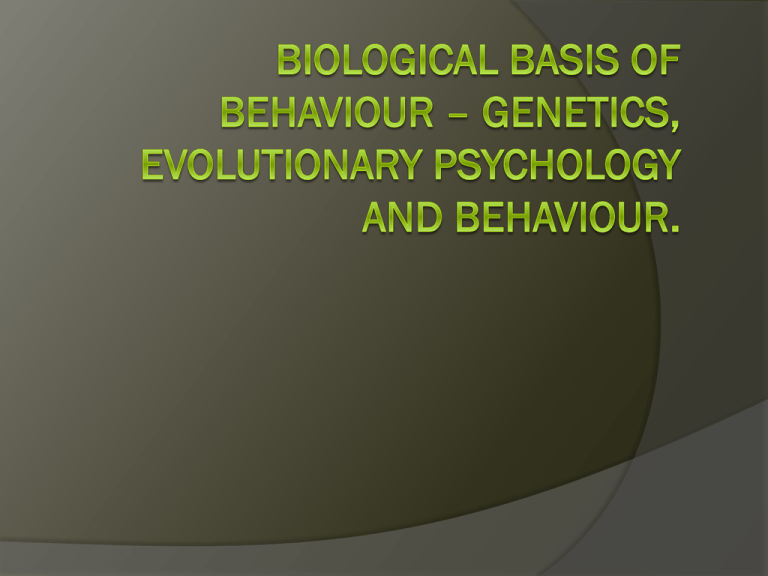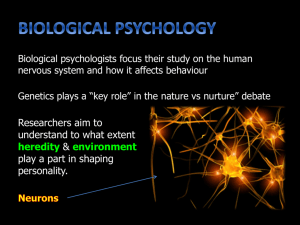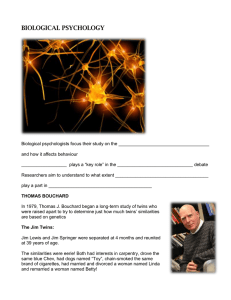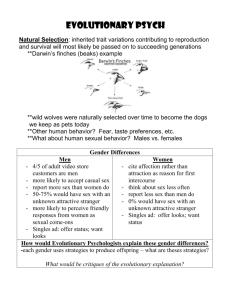File
advertisement

When we talk about genetics, we are talking about what makes you… you! We are all beautiful unique snowflakes (awwww!) but our genes made us that way. The species Homo sapiens have members that are leaves of one tree… commonalities between us. Our shared brain architecture allows us to sense our world, develop language and feel hunger all the same. The question comes from how much do our genes influence our outcome versus our environment? Behavior Genetics: Predicting Individual Differences Behaviour Genetics the study of the relative power and limits of genetic and environmental influences on behavior. Will Angeline Jolie and Brad Pitt’s kids grow up to be actors? Environment every non-genetic influence, from prenatal nutrition to the people and things around us. Genes: Our Codes for Life Crash Course Genetics: Humans have 46 chromosomes in each of their cells nuclei. 23 from the father (sperm, 23 from the mother (egg). Chromosome threadlike structures made of DNA molecules that contain the genes. DNA a complex molecule containing the genetic information that makes up the chromosomes. AKA Deoxyribonucleic Acid Genes the biochemical units of heredity that make up the chromosomes; segments of DNA capable of synthesizing a protein. (Beads on the necklace) Genes can be active or expressed, or inactive, and not express. Genome the complete instructions for making an organism, consisting of all the genetic material in that organism’s chromosomes. (Whole necklace) Environmental events ‘turn on’ genes, causing proteins to be made, which in turn are the building blocks of the physical environment. Genetically speaking, every other human being on Earth is 99.9% the same as you. Every chimpanzee is about 96% the same as you. We share half of our genes with the banana for PETE SAKE! Twin and Adoption Studies Studies usually involve controlling either the home environment while varying hereditary OR controlling hereditary while varying the home environment. Unethical to set this up in real life, so case studies are the best way to go. Identical Twins twins who develop from a single fertilized egg that splits in two, creating two genetically identical organisms. Natures human clones! Although identical twins have the same genes, they don’t always have the same number of copies of those genes. Explains why one twin only can get a disease. Most identical twins share 1 placenta during development. 1 in 3 cases has 2 placentas, 1 for each twin. Explains some differences in identical twins later on. Sometimes called monozygotic twins. Fraternal Twins twins who develop from separate fertilized eggs. They are genetically no closer than brothers and sisters, but they share a fetal environment. Sometimes called dizygotic twins. Identical Versus Fraternal Twins University of Minnesota study on the ‘Jim Twins’ – follow along pages 97-98 Separated twins are more likely to be similar if they are identical, rather than fraternal. The disclaimer – ‘ The plural of anecdote is not data’ If any 2 strangers were to spend hours comparing their behaviours and life histories, they would probably discover many coincidental similarities. Twin studies can be highly criticised for this reason. Twins growing up apart: https://www.youtube.com/watch?v=Wd5 Y3-F79LY Nature vs Nurture Twins https://www.youtube.com/watch?v=bRK bZtpBcgI Biological VS Adoptive Relatives Difference between biological relative (biological parents and siblings) and environmental relatives (adoptive parents and siblings). The question comes from are adopted children more like their biological parents that gave them their genes, or like their adoptive parents who contributed the home environment? NATURE VS NURTURE When studying adoptive families, it is shown that people who grew up together, whether biologically related or not, do not resemble one another in personality. In traits such as extraversion and agreeableness, adoptees are more likely to be like their biological, rather than adoptive parents. The environment shared by a family’s children has virtually no discernible impact on their personalities. The genetic leash may limit the adoptive family’s environmental influence, but universally, parents DO influence their children’s attitudes, values, manners, faith and politics. Due to the fact that adoptive parents are screened before adoption takes place, divorce, child abuse and neglect are less than in biological families. Why are children in the same family so different? DISCUSS! Heritability Heritability the proportion of variation among individuals that we can attribute to genes. The heritability of a trait may vary, depending on the range of populations and environments studied. Differences among people. For example, using twin studies, behaviour geneticists can mathematically estimate the likelihood of a person inheriting a genetic trait from their parents. Keep in mind, although we can use heritability to predict the outcome of a gene, we cannot say it contributes a certain percent overall to personality and behaviour. Rather, heritability refers to the extent to which difference among people are attributable to genes. Boys Raised in Barrel Study Mark Twain jokingly proposed to raise boys in barrels, feeding them through a hole up to the age of 12. If we were to actually do this the boys would all emerge with lower than normal intelligence scores. Yet, given their equal environments, their scores would only be explained by their heredity. Group Differences Heritable differences between individuals does not imply heritable group differences. Ex) group differences between men/women, different races, etc. For example, height and weight are highly heritable, yet nutritional influences, rather than genetic influences (the genes have not changed) explain why, as a group, today’s adults are taller and heavier than those a century ago. Environment acts on genetics. Heritability – The Nature vs Nurture Debate of adaptation – ex) both of our eyes will develop the same in any sort of environment. However, walk around barefoot all summer, the feet will adapt to be rough – biological adaption to friction. Our shared biology enables our developed diversity. Nature and nurture work together Influence Genes are self-regulating – rather than act like the blueprint that lead to the same result no matter the context, genes react. People with identical genes but differing experiences have similar but not identical minds. Ex) Identical twins who marry different spouses with different personalities. Eating disorders are genetically influenced; Some individuals are more at risk than others… But culture influences what we see, and can cause those disorders to express more in different societies. Genes and experience are both important. They interact the interplay that occurs when the effect of one factor (such as environment) depends on another factor (such as heredity). Environments trigger gene activity genetically inherited traits invoke expression in other people as well. Called Evocative Interactions. Think of how parents may treat each of their children differently – child's nature and parents nurture interact. Aggressive student causes normally calm teacher to lose it. So what’s the big deal Teacher Lady? From conception onward, we are the product of a cascade of interactions between our genetic predispositions (NATURE) and our surrounding environments (NURTURE). Our genes affect how people react to and influence us. Biological appearances have social consequences. Gene Environment Interaction – Why do we respond differently to Will Ferrell than to Channing Tatum? FORGET NATURE VS NURTURE…. THINK NATURE VIA NURTURE!!! Molecular genetics Goal is to identify specific genes that influence behaviour. Molecular Genetics the subfield of biology that studies the molecular structure and function of genes. The goal of molecular behaviour genetics is to find some of the many genes that influence normal human traits, such as body weight, sexual orientation and extraversion, and to explore how mechanisms control the expression of those genes. This also comes into play when predicting, understanding and researching genetically inherited diseases. Molecular geneticists team with psychologists to find the genes associated with: Learning disabilities Depression Schizophrenia Alcohol dependence Bipolar disorder Connect DNA of families with history of the disease with scientists to do research on specific genes. Allow families to know outcomes of fetuses before they are born. Will labelling a fetus with a ‘risk of’ a psychological disorder lead to discrimination? Or will it allow supports to be put in place early on? India/China debate DISCUSS! Evolutionary Psychology Evolutionary Psychology the study of the evolution of behavior and the mind, using principles of natural selection. Natural Selection the principle that, among the range of inherited trait variations, those that lead to increased reproduction and survival will most likely be passed on to succeeding generations. Proposed by Charles Darwin Natural Selection 101 Organisms' varied offspring compete for survival. Certain biological and behavioural variations increase organisms’ reproductive and survival chances in their particular environment. Offspring that survive are most likely to pass their genes to ensuing generations. Population characteristics change over time. What does the fox say?... Er… how does it evolve? Foxes = wild animals Wolves were wild animals… bred, over time, into domesticated dogs for specific traits Sheepdogs herd, Retrievers retrieve and Trackers track, etc. Can we do the same with foxes? YUP! Over 30 generations of foxes, the tamest of the bunch were bred together. This trait was SELECTED for. 40 years and 45,000 foxes later = domesticated foxes. You can have a fox as a house pet in Russia.. OMG! Domestication of Foxes in Russia http://documentarystorm.com/dogsdecoded/ 36 minute mark Over time, nature will select advantageous variations from among mutations the random error in gene replication that leads to a change. This creates new gene combinations in each human. Humans are able to ADAPT to environmental conditions, based on their genes. This measures their level of FITNESS. (aka Survival of the Fittest) Evolutionary Psychology https://www.youtube.com/watch?v=vJdc 9zGYVjU Evolutionary Success Helps Explain Similarities Behaviors that contribute to survival are found throughout cultures. Name some survival behaviors. Evolutionary Success Helps Explain Similarities Outdated Tendencies Genetic traits which helped our ancestors survive may harm us today. Explain why this picture is included. Evolutionary Success Helps Explain Similarities Evolutionary Psychology Today The application of Darwin’s ideas in the science of psychology has been called“the Second Darwinian Revolution”. How does Evolution help Psychologists? This ‘second evolution’ has allowed psychologists to address questions such as: Why do infants start to fear strangers about the time they become mobile? Why are biological fathers so much less likely than unrelated boyfriends to abuse and murder the children with which they share a home? Why do so many people have phobias about spiders, snakes, heights than about more dangerous threats like guns and electricity? Why do humans share some universal moral ideas? DISCUSS! An Evolutionary Explanation of Human Sexuality Gender Differences in Sexuality Studies suggesting men have a stronger tendency towards sex. Desire sex more frequently, think more about sex, initials more sex and will sacrifice more to gain sex. Lower threshold for perceiving warm responses as a sexual come on. An Evolutionary Explanation of Human Sexuality Natural Selection and Mating Preferences Differing preferences in partners Male preferences – recreational, pair widely, attracted to youthful appearance, healthy, fertile appearing, waist 1/3 narrower than hips, age of peak fertility. Female preferences – relational, pair wisely, attracted to mature, dominant, bold, affluent men, potential for long term mating, investing in joint offspring. Nature Selects behaviours that increase the likelihood of sending one’s genes into the future, whether you are male or female. https://www.youtube.com/watch?v=iGoC 8FTLKSI Critiquing the Evolutionary Perspective theorizing – Paragraph 1, page 107 Impact of social influence – roles have changed over time. Backward






